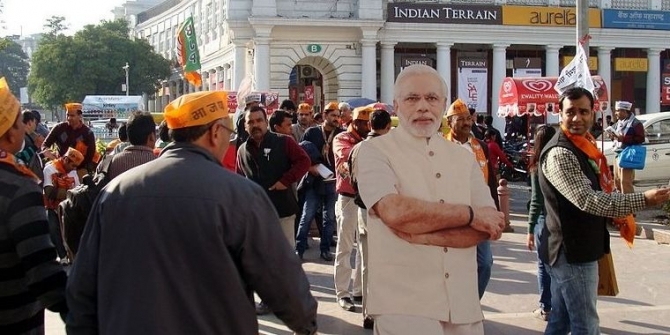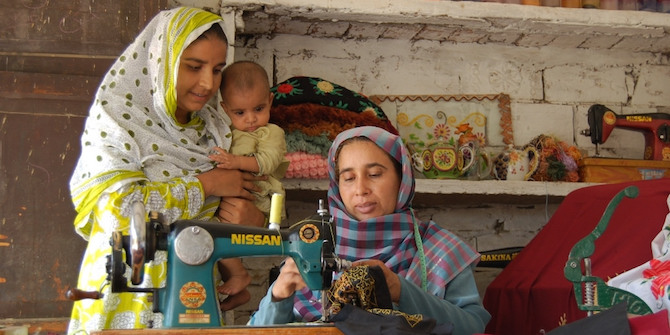
Drawing on data from Balochistan, Asmat Kakar and Ghulam Rasool Baloch argue that the new provincial government is well placed to further implement ongoing community driven programmes, with the potential to extend this kind of intervention to all districts.
The poorest of the poor are the landless in rural areas, followed closely by the land-poor – those whose landholdings are too small or production is too low to support a household. This demographic makes up the majority of the rural poor and hungry and it is in rural areas where the worst poverty and hunger are found. Likewise, the majority of population, particularly in rural areas in Balochistan province are living in chronic poverty due to many causes including: limited means of livelihood;, drought, water scarcity; poor access to social services; a huge number of unskilled and untapped young population; and having no agricultural land.
This article uses the most recent data collected from 3,13,447 rural households from eight districts of Balochistan province, surveyed under Balochistan Rural Development and Community Empowerment (BRACE) Programme, to examine the underlying dynamics of chronic poverty, and what policy measures should be taken to alleviate poverty in the province. Besides other factors responsible for abject poverty in the province, the census data shows a strong linkage between high poverty and landlessness.
The census demonstrates that, overall, 92.3% households in the eight districts do not have their own agricultural land. In district Washuk 96.7% households do not have their own agricultural land, and it is the poorest district among the eight districts given in the Table-1. In the same way, 96.2% households in district Killa Abdullah are landless which is why the district has the second highest number of households falling in extreme poverty bands. Even though, relatively, district Killa Abdullah is on second number in terms of poverty, it has the highest number of households falling in the poorest band (0-11). The situation is similar in all the remaining districts where most of the households’ do not have their own agricultural land.
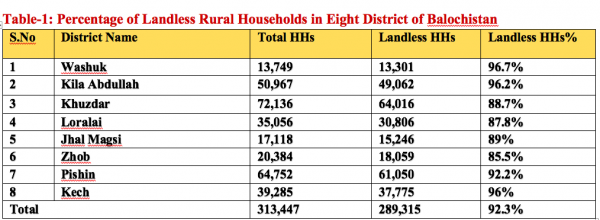
Source: BRACE-RSPN
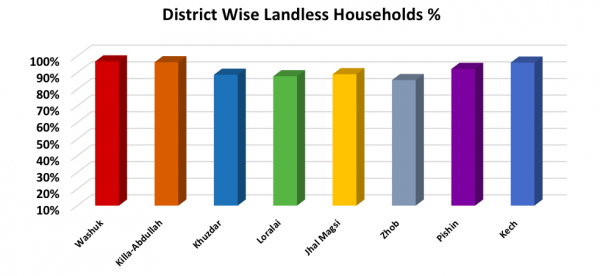
Source: BRACE-RSPN
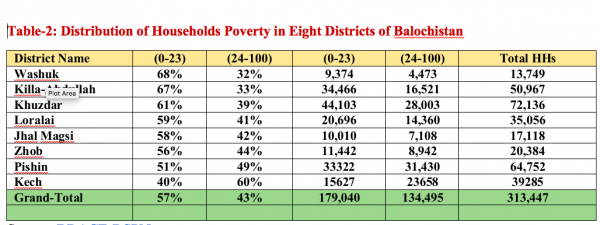
Source: BRACE-RSPN

Source: BRACE-RSPN
The question that arises out of this census is what are the possible solutions for moving these 57% rural households in aforementioned districts out of poverty? The more pragmatic and on the ground deliverable solution, keeping in view the context of Balochistan, is to create alternative means of livelihood such as equipping youth with quality technical and vocational education, provision of income generating grants, and the formation of Community Investment Funds (CIFs). The main purpose of Community Investment Fund (CIF) is to provide a capital grant by the Rural Support Programmes (RSPs) to Community Institutions (CIs). The CIF is targeted at poorest households, and is used by the CIs as revolving fund. Poverty Score Card (PSC) is used to identify the eligible households to ensure that only the poor and poorest households (with Poverty Score 0-23) get access to CIF capital and start income generating activities. The evidence from many studies suggest that such kind of pro-poor interventions can help poor households to help themselves take out of poverty
The BRACE Programme is one of a number of community driven development programmes which intends to apply the aforementioned solutions for reducing poverty in these districts. In this regard, first, these 3,13,447 households will be organised into people’s own community organisations followed by the development of Micro Investment Plans (MIPs) at household level. In MIPs, each household, with support of Rural Support Programmes experts, will identify its needs and potential. BRACE Programme interventions will accommodate every poorest household falling in poverty band (0-23) and provide support to each and every household for the execution of their MIPs.
Besides, development of MIPs, the BRACE Programme will support people’s own community organisations in development of Village Development Plans (VDPs), and Union Council Development Plans (UCDPs) to identify their basic social needs, consolidate it in VDPs and UCDPs, and then establish linkages with local government for execution of objectives set in the plans. Moreover, at policy level, the evidence to be generated through successful and effective implementation of programme interventions, will be used in the formulation of a provincial level Community Driven Local Development (CDLD) Policy recognized by The World Bank as ‘important elements of an effective poverty-reduction and sustainable development strategy’.
The new provincial government in Balochistan will be well placed to benefit from further implementation of the ongoing community driven programme, with the potential to extend this kind of interventions to all districts by prioritising it in the annual provincial Public Sector Development Programme (PSDP). Finally, the provincial government should establish local governments as soon as possible to support populations living in rural areas in getting access to better social services.
Cover image: A woman in Pakistan receives training in dress making. Photo credit: ILO, Flickr, CC BY-NC-ND 3.0 IGO.
This article gives the views of the author, and not the position of the South Asia @ LSE blog, nor of the London School of Economics. Please read our comments policy before posting.
About The Authors
 Asmat Kakar is a Monitoring and Evaluation Officer for European Union Funded Balochistan Rural Development and Community Empowerment Programme. He completed his MSc in Social Policy and Development at the London School of Economics and Political Science in 2016. He tweets @asmatkhan19.
Asmat Kakar is a Monitoring and Evaluation Officer for European Union Funded Balochistan Rural Development and Community Empowerment Programme. He completed his MSc in Social Policy and Development at the London School of Economics and Political Science in 2016. He tweets @asmatkhan19.

Mr. Ghulam Rasool Baloch is working as Programme Manager for Balochistan Rural Development and Community Empowerment (BRACE) Programme at the National Rural Support Programme (NRSP).





